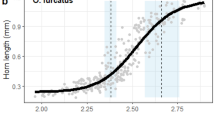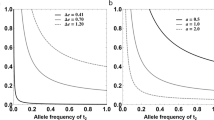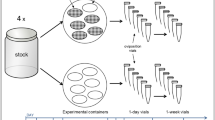Abstract
THERE is growing evidence that adaptation may relate to precise conditions of an individual's phenotype, though previous studies have concentrated on discontinuous variation1. We show here that the copula duration of male dungflies, a widely cited example of optimally in biology2–5, is tuned precisely and continuously to the size of the copulating male. During copulation, new sperm displace previously stored sperm at a rate that shows exponentially dimin-ishing returns6. Thus at the optimal copula duration a male's paternity gains from continued copulation drop below that expected from searching for a new female. Small males have lower rates of sperm displacement7; they also have less prospect of copulation by take-over of females from other males8,9. Both effects predict that small males will copulate for longer, although displacement differences exert much the stronger influence. Observed copula durations are negatively correlated with size and concur with the optimality model across the natural male size range. This represents one of the first quantitative demonstrations of optimal responses covarying with a continuous aspect of phenotype. Phenotype-limited optimality profiles pose interesting evolutionary questions.
This is a preview of subscription content, access via your institution
Access options
Subscribe to this journal
Receive 51 print issues and online access
$199.00 per year
only $3.90 per issue
Buy this article
- Purchase on Springer Link
- Instant access to full article PDF
Prices may be subject to local taxes which are calculated during checkout
Similar content being viewed by others
References
Thornill, R. & Alcock, J. The Evolution of Insect Mating Systems (Harvard Univ. Press, Massachusetts, 1983).
Krebs, J. R. & Davies, N. B. An Introduction to Behavioural Ecology (Blackwell Scientific, Oxford, 1993).
Huntingford, F. The Study of Animal Behaviour (Chapman and Hall, London, 1984).
Sober, E. Philosophy of Biology (Oxford Univ. Press, Oxford, 1993).
Kitcher, P. Vaulting Ambition: Sociobiology and the Quest for Human Nature (MIT Press, Massachusetts, 1985).
Parker, G. A. & Simmons, L. W. Proc. R. Soc. B246, 107–115 (1991).
Simmons, L. W. & Parker, G. A. Evolution 46, 366–375 (1992).
Borgia, G. Behaviour 75, 185–206 (1980).
Sigurjonsdottir, H. & Parker, G. A. Behav. Ecol. Sociobiol. 8, 219–230 (1981).
Parker, G. A. J. anim. Ecol. 39, 205–228 (1970).
Fretwell, S. D. Populations in a Seasonal Environment (Princeton Univ. Press, Princeton, 1972).
Parker, G. A. & Stuart, R. A. Am. Nat. 110, 1055–1076 (1976).
Charnov, E. L. Theor. Popul. Biol. 9, 129–136 (1976).
Parker, G. A., Simmons, L. W. & Ward, P. I. Behav. Ecol. Sociobiol. 32, 157–166 (1993).
Parker, G. A. J. Insect Physiol. 16, 1301–1328 (1970).
Sigurjonsdottir, H. Evolutionary Aspects of Sexual dimorphism in Size: Studies on Dung Flies and Three Groups of Birds (University of Liverpool, 1980).
Parker, G. A. in Behavioural Ecology: An Evolutionary Approach (eds Krebs, J. R. & Davies, N. B.) 214–244 (Blackwell Scientific, Oxford, 1978).
Parker, G. A. Am. Nat. 139, 1237–1256 (1992).
Foster, W. Science 158, 1596–1597 (1967).
Stevens, D. W. & Dunbar, S. R. Behavl Ecol. 4, 172–183 (1993).
Ward, P. I. & Simmons, L. W. Behav. Ecol. Sociobiol. 29, 77–85 (1991).
Parker, G. A., Simmons, L. W. & Kirk, H. Behav. Ecol. Sociobiol. 27, 55–65 (1990).
Parker, G. A. Behaviour 37, 140–168 (1970).
Author information
Authors and Affiliations
Rights and permissions
About this article
Cite this article
Parker, G., Simmons, L. Evolution of phenotypic optima and copula duration in dungflies. Nature 370, 53–56 (1994). https://doi.org/10.1038/370053a0
Issue Date:
DOI: https://doi.org/10.1038/370053a0
This article is cited by
-
Competitive males have higher quality sperm in a monogamous social bee
BMC Evolutionary Biology (2016)
-
Reproductive behavior of the masson pine caterpillar, Dendrolimus punctatus (Lepidoptera: Lasiocampidae) under laboratory conditions
Applied Entomology and Zoology (2016)
-
Large donors transfer more sperm, but depletion is faster in a promiscuous hermaphrodite
Behavioral Ecology and Sociobiology (2014)
-
Elucidating the function of ejaculate expulsion and consumption after copulation by female Euxesta bilimeki
Behavioral Ecology and Sociobiology (2013)
-
Response to selection and realized heritability of sperm length in the yellow dung fly (Scathophaga stercoraria)
Heredity (2010)
Comments
By submitting a comment you agree to abide by our Terms and Community Guidelines. If you find something abusive or that does not comply with our terms or guidelines please flag it as inappropriate.



